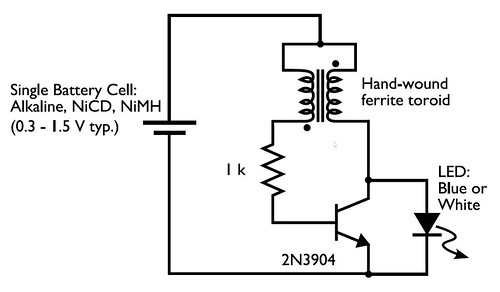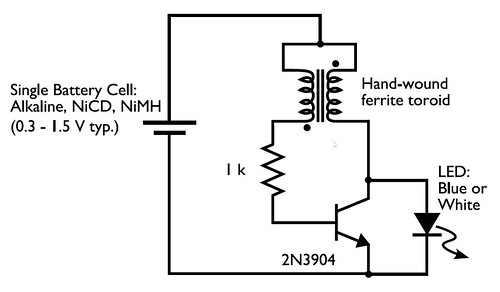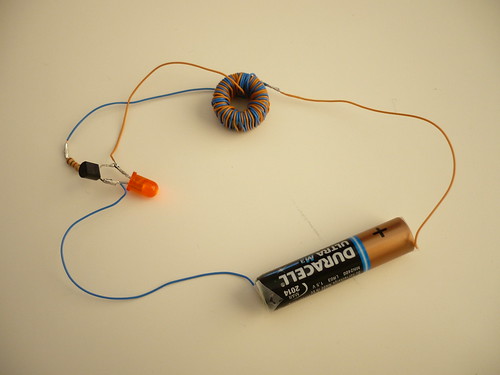
Obviously all preppers are interested in getting off the grid, saving energy, or creating their own energy, but let’s say that you need to light up your campsite and all you have are several “dead” batteries. Did you know that a typical 1.5v AA battery is usually considered dead when it’s down to anywhere from .9 to 1.3V?
It all depends on the circuit that your device uses but you can assume that it’s dead after about 20% of it’s voltage is used. So that means that almost 100% of the batteries out there that have been thrown away as dead, aren’t really dead. Of course, that doesn’t really mean much when those batteries can’t be used in the device that you want. Also, of course, I should have made a post about how to make homemade batteries made from easy-to-find crap you can find in any junkyard or abandoned house before this one but I didn’t.
What if I told you that if you pulled a few parts off of just about any junk electronics crap that you have around that you could make a very simple circuit that could power devices that require a higher voltage than your batteries actually have? What I’m going to show you today is very simple, very cheap, and can be used to do things like power a flashlight when you don’t really have any power around. I go into a lot of detail for those who really want to understand deeper, but you don’t really have to understand much to get it to work. You could just get the parts and put them together as shown in the video. Feel free to ask any questions below though. You can just skip the technobabble section if you just want to get to it.
This build is a little more technical than most people are comfortable with but it’s something you should really look into. If SHTF, you may need to have power for something but have either only dead batteries around or no batteries. Making a battery is pretty simple to do but making a powerful one is harder. This circuit can make things work even with a crappy battery made out of saltwater and a couple of pieces of metal.
Here is the basic idea of how you make a Joule Thief circuit. You pretty much don’t have to do anything but watch this video and do what it says to but I’m gonna go into deeper detail in case you need it.
What parts do you really need?Here’s the basic list if you don’t want to get complicated:
– Ferrite toroid core (can also be found in old CFL bulbs)
– Old/Used/Homemade Batteries (can also be found in garbage cans or old remote controls you haven’t used in years)
– 2N3904 NPN transistor (almost every kind of electronics has these but the small things like cell phones have teensy ones that you probably won’t want to use)
– 1k Ohm resistor (the size isn’t all that important but will affect the circuit.
– LED (by itself or inside a flashlight)
– Multimeter (optional but it’ll help troubleshoot the circuit)
– 22 gauge magnet wire
– AA battery holder
Start of technobabble section
Just so you know, just about any NPN transistor will work. If you click on the link above and don’t like what you find, just put ‘NPN transistor’ in the search field and buy whatever you want. The technicalities of whatever the differences are with the 3904 and what you need aren’t all that important. You can even use a PNP but you’ll have to adjust the schematics a bit to reverse things where they need to be.
Think of the possibilities. Even if you don’t have dead batteries around, it’s extremely simple to make batteries out of a few parts that you can find pretty much anywhere but those batteries aren’t very efficient. With a circuit that could use dead batteries to power certain things like LED lights, you could also use fresh homemade batteries.
But how do you make this work? Well, you start following me, for one thing. The next few paragraphs might seem a little technical but you don’t really have to understand them unless you want to design your own stuff outside of what I’m going to show you.
There is a law in physics that states that whatever energy goes into a system, comes out of it. No matter what. This is the first law of thermodynamics, called the “conservation of energy” law. Basically, if you put something in, you get EXACTLY that out of it. There’s no free ride, no matter how much those free energy kooks keep trying to sell you something that looks like it’s free. Now, if you consider that something like solar power is “free” in that it’s there even though you don’t have to pay for it, then you can consider it free. Otherwise, someone is paying for it. Probably with my taxes.
Now, what the heck does this have to do with trying to get some light in your campsite or your post-SHTF compound? Well, the truth is that, depending on the circuit, some things run your power source dead because it doesn’t have enough current and some because it doesn’t have enough voltage. I’m not gonna go into everything here about that because you’d be signing up for an Electronics 101 course to go through it, but here’s a very tiny amount of math for you.
Power is what the conservation of energy is all about. To be specific, energy is the amount of work something can do and power is how fast something can do that work. For your purposes, one is enough to do what you need it to do and one is either how strongly or how long you can do it, depending on the circuit.
In the matter of electricity, Power (in watts) is equal to Electromotive Force (EMF in Volts) X Current (in Amps). That means that if you have a circuit that has a total usable power of ‘P’, all you have to do to calculate it is take the voltage (Direct Current or the equivalent Direct Current) and multiply it by the current. By usable, I mean what’s left over after all the inefficiency that’s bled off the system by heat and light, etc.
Now this might not be immediately obvious but think about this for a second. What if you had a Thing that needed 2 volts but you only had a power supply that had 1 volt? If you manipulate the input a little, you may still be able to make this work.
In reality, something that requires 2 volts still requires some amount of current but it’s probably not that important so it isn’t mentioned. Let’s say that we’re talking about a light that takes 2 volts to light up and the minimum current is 100 milliamps (A milliamp is 1/1000 of an amp). The minimum power under perfect circumstances would then be (2 times 100/1000) or .2 Watts. As long as you had .2 watts coming out of your power supply, including all the losses in the system, you can still run it if you can change voltage to amps or amps to voltage.
Here’s a simple video about how transformers work. For our purposes here, you can almost consider transistors to work in the same way but they don’t always:
Hmmm. So if you haven’t had some kind of training in this stuff, you’re probably wondering what the hell I’m talking about and how you can actually use it. Be patient my young apprentice; I’m about to get there.
To put it simply, if you have something with 1 volt and 1 amp, if you somehow double the output to 2 volts (and ignore the efficiency of the system), you can get 0.5 amps out and not break the laws of physics which would then create an enormous singularity and destroy all that exists, has existed and will every exist.
There is a very simple thing that can actually do this. It’s called an amplifier. If you put a certain amount of windings on one side of a transformer for example, and double the amount on the other side, you can turn 1 volt into 2 volts. Your cost is half of the current you started with plus any heat or light (light is pretty much negligible) that the transformer will lose, plus a little bit of impedance loss (which if you’ve never heard of impedance, you don’t have to worry about).
Another way to do this is to use an amplifier, which we’re gonna use today (actually both but I wanna keep things simple to understand). If you amplify a voltage in a circuit, it’s permissible as long as you lose current and some heat.
But how do you do this with crap you can find from some thrown-away TV set or whatever?
An amplifier circuit will pretty much need some version of an alternating current. The voltage in your walls (providing you’re in the U.S.) is 120 volts alternating current (RMS, which means Root Mean Square), which alternates at 60 times per second. I’m not gonna go into the math here but that means that it goes to about 170 volts and then to minus 170 volts but this is equal to about 120 volts of direct current (like a battery). The problem is that a battery is direct current. Direct current is pretty much always the same voltage. When it’s always the same voltage, you can’t use other physics that dweebs (or boffin, depending on what side of the pond you’re on) use to change one voltage to a magnetic force that is felt by the other end of a transformer and multiplied by the difference in windings. Double the windings is double the voltage. If that is a bit confusing, and you really care about all the nitty-gritty details about every step, read this post.
Now, a transistor is a little more complicated but it can work in a similar way if it’s hooked up a certain way. Here’s a little bit about how they work but you can skip it if you don’t want to get into too many details.
So what the heck does this all actually mean for the average prepper who has some crap around the house and wants to make some lights or power some kind of electronics that hasn’t been fried?
The easiest power to make is direct current (DC). All you really need is two different metals and some kind of acid or salt to start a reaction with both. As long as one metal has a reaction that gives electrons and the other takes electrons, you’re on your way to make a cell. If you add cells in series, they add their voltages together. If you add them in parallel, they add their currents together. Again, too much for this post but follow along and you’ll see enough to get you started.
The problem is that a typical cell only makes about .5 to .7 volts, and not a lot of current. It also won’t last very long by itself.
But, if you have something that doesn’t take a lot of power, and is just lacking the voltage to run it, you can fix that.
By using a circuit that oscillates naturally, you can take the voltage that you have and make it go above and below what you started with. It’s not magic; you still have the total amount of energy you started with. What this gives you, however, is a different form of usable energy. Voltage (essentially current) that continuously moves above and below a certain value is alternating current. Alternating current can be amplified by either a transformer or certain transistor circuits.
As preppers, we’re concerned with what would be available at minimum, in the maximum amount of circumstances. In this case, since we’re concerned about small power such as LED lights or similar, something called a Joule Thief is just what we need.
A joule is a unit of energy, which can be modified into many different systems but in our case is Watts per Second. A Joule Thief is a play on words because it allows you to steal watts from dead or inefficient batteries for many, many seconds, if not weeks.
End of technobabble section
The most basic schematic for a Joule Thief circuit (this and the next pic are from How to Get What You Want).

Here’s what it looks like if you don’t know how to read a circuit.

Here’s a video that explains how to make a Joule Thief circuit with simple parts.
Here’s a quick explanation how a Joule Thief circuit works.
So, essentially, a joule thief takes your direct current (battery stuff), changes it to some form of alternating current (like in your wall but not as smooth), and amplifies it to a higher voltage (at the expense of current and heat loss so tell those free energy punks to piss off). This makes certain things work that only care about higher voltage and aren’t concerned about the purity of the signal coming in or a lot of current. Things like LED lights. It can’t do things like power a car or a refrigerator (although you could do some playing around and upsize the circuit if you wanted to).
Don’t get me wrong, it’s a genius circuit. It’s exactly the kind of thing that gets me excited. It takes crap you can find from any junkyard or abandoned house and converts it into something useful to make your life more comfortable or even keep you alive. It’s just not all that complicated.
There are other versions of the circuit out there as well. Some are more efficient than this simple one and some are pure bullshit to get you to buy their schematics or to get someone some temporary form of notoriety before a real man kicks his ass. Do a search on youtube for ‘Joule Thief’ and you’ll see lots of videos explaining things and showing you how to build one or different offshoots of one.
I’ve studied the joule thief for a while now and the theory’s sound. I haven’t actually built one and improved on the model yet though so those posts are coming. If you’re new to electronics or just want a good all-encompassing book, I recommend Electronics All-in-One For Dummies.
What I’m challenging you to do is use what you’ve learned here and make your own joule thief circuit in some way that allows you to use either dead batteries or homemade batteries to power something useful for comfort or survival during a scenario involving a power outage. If you do this, please post the link to your accomplishment in the comments below along with a suitable explanation as to what we’ll be looking at if we click on it.
Here are a few websites to start with in case you want to go further than what this post goes into:
Weekend Projects with Bre Pettis: Make a Joule Thief
Power Law: The relationship between voltage, current an watts
Here’s an example of using one AAA battery to power a flashlight that normally requires 3 of them. It’s just a taste of what you can do with the knowledge you now have.
If you have any questions, please ask in the comments below. If you’re not sure, then there are probably 100 other people who aren’t as well but they don’t have enough guts to ask. The big thing to take away from this is that the parts required to do this are easily found in almost any decent-sized electronic thingymajiggy so if you have a way to remove the parts with a soldering iron or whatever, you can do this pretty easily.
Now, one of the next things I’m working on is a simple way to power something useful such as LED lights using either dead batteries or homemade batteries. I’ll be posting that as soon as I find a method that’s suitable for preppers. If you have something that you think will work, please post it below so we can all learn from your awesomeness.
If you’d like to learn how to make more DIY prepper projects (that aren’t quite so technical), check out my DIY Prepper section.








Great article!
There’s a book in this… scavenged or improvised DIY, SHTF electronics.
Wishlist: Radio (receiver/transmitter), joule thief, geiger counter, metal detector, magnetizer, clock/timer, trip-wire alarm (motion sensor?), PV array… LOTs of useful stuff.
To give something back, here’s a link to Frayne’s WINDBELT Generator, which fits this category of tool: http://www.popularmechanics.com/science/energy/solar-wind/4224763
You’ve got me thinking along some whole, new lines!
This are quite educative and we from the remote world indeed need this information.
Thanks.
Thanks. I hope there’s a lot like you, who really understand what the world needs and teaching practical knowledge. Enlightening more people.
Hi
I stumbled upon this searching for something entirely different. A clever idea. I’m including this circuit in a book I’m writing, (with acknowledgement, of course).
Regards
Colin